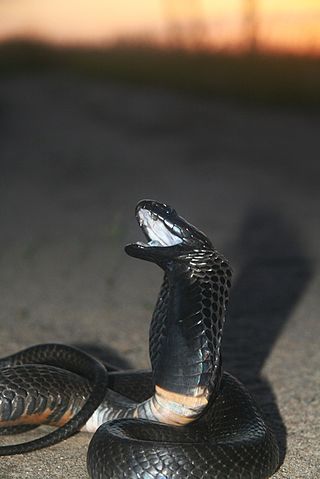
George Albert Boulenger was a Belgian-British zoologist who described and gave scientific names to over 2,000 new animal species, chiefly fish, reptiles, and amphibians. Boulenger was also an active botanist during the last 30 years of his life, especially in the study of roses.

A ”spitting” cobra is any of several species of cobra that can intentionally, defensively shoot their venom directly from their fangs. This substance has two functions, with the first being as venom that can be absorbed via the victim’s eyes, mouth, or nose, and secondly as a toxungen, which can be sprayed on the target surface. Their ability to target and shoot venom is utilised in several different ways, self-defense being the most common instance. Studies have shown that the targets are far from random; rather, spitting cobras consciously take aim, directing their spray as close as possible to the eyes and face of an aggressor.

The monocled cobra, also called monocellate cobra and Indian spitting cobra, is a venomous cobra species widespread across South and Southeast Asia and listed as Least Concern on the IUCN Red List.

The Caspian cobra, also called the Central Asian cobra, ladle snake, Oxus cobra, or Russian cobra, is a species of highly venomous snake in the family Elapidae. The species is endemic to Central Asia. Described by Karl Eichwald in 1831, it was for many years considered a subspecies of the Indian cobra until genetic analysis revealed it to be a distinct species.

The Cape cobra, also called the yellow cobra, is a moderate-sized, highly venomous species of cobra inhabiting a wide variety of biomes across southern Africa, including arid savanna, fynbos, bushveld, desert, and semidesert regions.

The Philippine cobra also called Philippine spitting cobra or northern Philippine cobra, is a stocky, highly venomous species of spitting cobra native to the northern regions of the Philippines. The Philippine cobra is called ulupong in Tagalog, carasaen in Ilocano.

Naja is a genus of venomous elapid snakes commonly known as cobras. Members of the genus Naja are the most widespread and the most widely recognized as "true" cobras. Various species occur in regions throughout Africa, Southwest Asia, South Asia, and Southeast Asia. Several other elapid species are also called "cobras", such as the king cobra and the rinkhals, but neither is a true cobra, in that they do not belong to the genus Naja, but instead each belong to monotypic genera Hemachatus and Ophiophagus.
Wolfgang Wüster is a herpetologist and Professor in Zoology at Bangor University, UK.

The many-banded snake, also known commonly as the burrowing cobra, is a species of venomous snake in the family Elapidae. The species is native to Central Africa. There are three recognized subspecies.

Python anchietae is a python species endemic to southern Africa. According to Donald George Broadley (1990), this species is most closely related to the ball python of western Africa, and no subspecies are currently recognized. It is named after the Portuguese naturalist and explorer José Alberto de Oliveira Anchieta. Like all other pythons, it is not venomous.

The Egyptian cobra is one of the most venomous species of snakes in North Africa, and has caused many snakebite incidents to humans. It averages roughly 1.4 metres (4.6 ft), with the longest recorded specimen measuring 2.59 metres (8.5 ft).

Naja ashei, commonly known as Ashe's spitting cobra or the giant spitting cobra, is a species of venomous snake in the family Elapidae. The species is native to Africa. It is the world's largest species of spitting cobra.

The Indochinese spitting cobra also called the Thai spitting cobra, black and white spitting cobra, Siamese spitting cobra, is a species of spitting cobra found in Southeast Asia.

The black-necked spitting cobra is a species of spitting cobra found mostly in sub-Saharan Africa. They are moderately sized snakes that can grow to a length of 2.2 to 3.0 m in length. Their coloration and markings can vary considerably. They prey primarily on small rodents. They possess medically significant venom, although the mortality rate for untreated bites on humans is relatively low. Like other spitting cobras, they can eject venom from their fangs when threatened. The neurotoxic venom irritates the skin, causing blisters and inflammation, and can cause permanent blindness if the venom makes contact with the eyes and is not washed off.

The snouted cobra, also called the banded Egyptian cobra, is a highly venomous species of cobra found in Southern Africa.

The forest cobra, also commonly called the black cobra and the black and white-lipped cobra, is a species of highly venomous snake in the family Elapidae. The species is native to Africa, mostly the central and western parts of the continent. It is the largest true cobra species with a record length of 3.2 metres.

The Arabian cobra is a species of venomous snake in the family Elapidae. The species is endemic to the Arabian Peninsula.

Naja nigricincta is a species of spitting cobra in the genus Naja, belonging to the family Elapidae. The species is native to the deserts and drier regions of southern Africa. The species is largely nocturnal, and is often found while crossing roads at night. There are two recognized subspecies.

Naja christyi, commonly known as the Congo water cobra or Christy's water cobra, is a species of venomous snakes belonging to the family Elapidae. The species is native to Sub-Saharan Africa.

The Javan spitting cobra, also called Indonesian cobra or Komodo spitting cobra, is a species of cobra in the family Elapidae, found in the Lesser Sunda Islands of Indonesia, including Java, Bali, Lombok, Sumbawa, Flores, Komodo, and others.




















